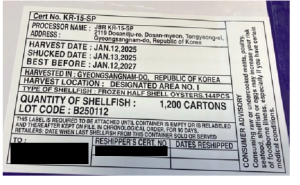All fields are required
Posted in Norovirus,Our Blog,Outbreaks & Recalls on August 24, 2025

A norovirus outbreak in Utah County has prompted the addition of more harvest dates to an existing U.S. Food and Drug Administration (FDA) advisory for frozen oysters imported from the Republic of Korea.
The Utah Department of Agriculture and Food (UDAF) Division of Regulatory Services, the Utah Department of Health and Human Services, and Utah County Health Department are investigating a norovirus outbreak impacting residents of Utah County. Epidemiological data points to frozen half shell oysters imported from the Republic of Korea.
An FDA advisory for this importer has been updated twice. The last, being a blanket warning for lots harvested during a specific date range.
Here’s what we know so far about the norovirus outbreak in Utah County and what to do if you get sick.
An announcement from UDAF indicates that there is a norovirus outbreak in Utah County. However, the true number of sick people had not been made available at this time.
It is also unclear as to whether outbreak patients consumed the contaminated oysters from retail purchases or at a restaurant that used oysters from the implicated supplier.
Reading between the lines on the UDAF advisory, I’m leaning toward restaurant exposure.
It seems that UDAF is concerned about restaurants in certain Utah counties, based on the advisory.
“UDAF is advising restaurants and retailers to not serve or sell, and consumers not to eat, any Korean frozen half shell oysters from Designated Area No. 1 harvested between December 30, 2024 and August 6, 2025.”
While no specific restaurant sources have been indicated, the advisory explains that in addition to Utah county, restaurants in Cache, Davis, and Salt Lake may have received contaminated frozen half shell oysters. Product may have also been further distributed to additional counties.
The initial advisory included a single lot of imported frozen, raw, half shell oysters from the Republic of Korea processed by JBR KR—SP harvested from Designated Area No. 1. In addition to Utah, these potentially contaminated mollusks were also distributed to Arizona, California, Colorado, and Montana.
This recall, posted on July 24, 2024 included a single lot (B250112) from a single harvest date (January 12, 2025).
Shortly after, the advisory was expanded to include additional lot codes and dates.
Within weeks, more products from JBR KR-15-SP were included in the advisory.
All half-shell and individually quick frozen (IQF) oysters harvested between December 30, 2024 and February 6, 2025. In addition to the original lot, additional frozen, raw, half-shell oyster lots included: B250103, B250106, B250114, B250119, B250121, B250123, and B250130. Frozen, raw, IQF oyster products included lot codes: B250108, B250116, and B250206.
After recent discoveries, even more oyster products from JBR, KR-15-SP have been indicated.
Now, the FDA has given a blanket advisory for the processor.
Now, the FDA advises that consumers, restaurants, and retailers should not eat, serve, or sell half shell and IQF oysters processed by JBR, KR-15-SP with harvest dates between December 30, 2024 and August 7, 2025.
All oysters should come with an “oyster tag.” This tag includes important information.

Picture from FDA
An oyster tag should include:
Restaurants are required to maintain these tags for 90 days after the last date the lots were served. This restaurant requirement is in place to aid traceback investigation activities, should the need arise.
If you have recently eaten oysters or may be involved in the norovirus outbreak in Utah County, you should monitor yourself for potential illness.
The most notable symptoms of norovirus infection are vomiting and diarrhea. For this reason, it is sometimes referred to as “the stomach bug” or “stomach flu” despite being an entirely unrelated virus from influenza due to some overlapping symptoms.
Common symptoms of norovirus infection include:
There is no cure for norovirus and due to the viral nature, no antibiotic treatment is effective against this type of infection. An infection also does not give you future immunity like some viruses. Sadly, you can become infected with norovirus many times throughout your life.
If infected, your best bet is to hydrate and rest until symptoms subside. If symptoms become severe or you become dehydrated, seek medical attention right away.
If you become sick from this norovirus outbreak in Utah County or beyond, there are a few things to keep in mind to help yourself throughout this difficult experience.
Gastrointestinal illness can deplete the body of important fluid. Especially if more water is leaving your system than you can replace.
Drink plenty of fluids and electrolyte drinks to maintain hydration. Avoid caffeinated or sugary drinks, as they could make your situation even worse.
If you have consumed oysters and begin feeling sick with symptoms consistent with norovirus, Utah Health wants to hear from you.
First, contact your healthcare provider. A test may be requested to confirm your illness. Then, report your illness to igotsick.health.utah.gov.
After reporting your illness, your health care provider or local health department will likely contact you for an interview. You will be asked to make a list of all of the foods and drinks you have consumed in the weeks prior to becoming sick.
Be as complete and accurate as possible. Include where you got the food and where you ate it.
Make this list as early as you are able to, while it is fresh in your mind. It is important that this list is complete and accurate.
Those with norovirus are highly contagious. For this reason, if you are, or suspect you are sick with norovirus, you should not prepare food for others for at least 48 hours after your symptoms end. If you work in food service, you need to notify your manager.
Foodborne illness is never fun. Especially if your symptoms are severe.
Medical bills, missed work, lost wages, and other burdens associated with foodborne illness add up. An experienced Norovirus Lawyer can help answer questions you may have about your legal rights, point you in the right direction for appropriate treatment, and help gather important evidence that can help your case. Even investigate the source of your illness.
If you have been impacted by this norovirus outbreak in Utah County or beyond and want to file a legal claim, The Lange Law Firm, PLLC has a norovirus Lawyer that can help!
Foodborne illness is inconvenient, disruptive to your personal and professional life, and in some cases serious or life-threatening. Most of the time foodborne illness is completely preventable. Lapses in food safety and sanitation result in illness.
Call (833) 330-3663 or send an email for a free, no obligation consultation to go over the details of your situation.
By: Heather Van Tassell (contributing writer, non-lawyer)